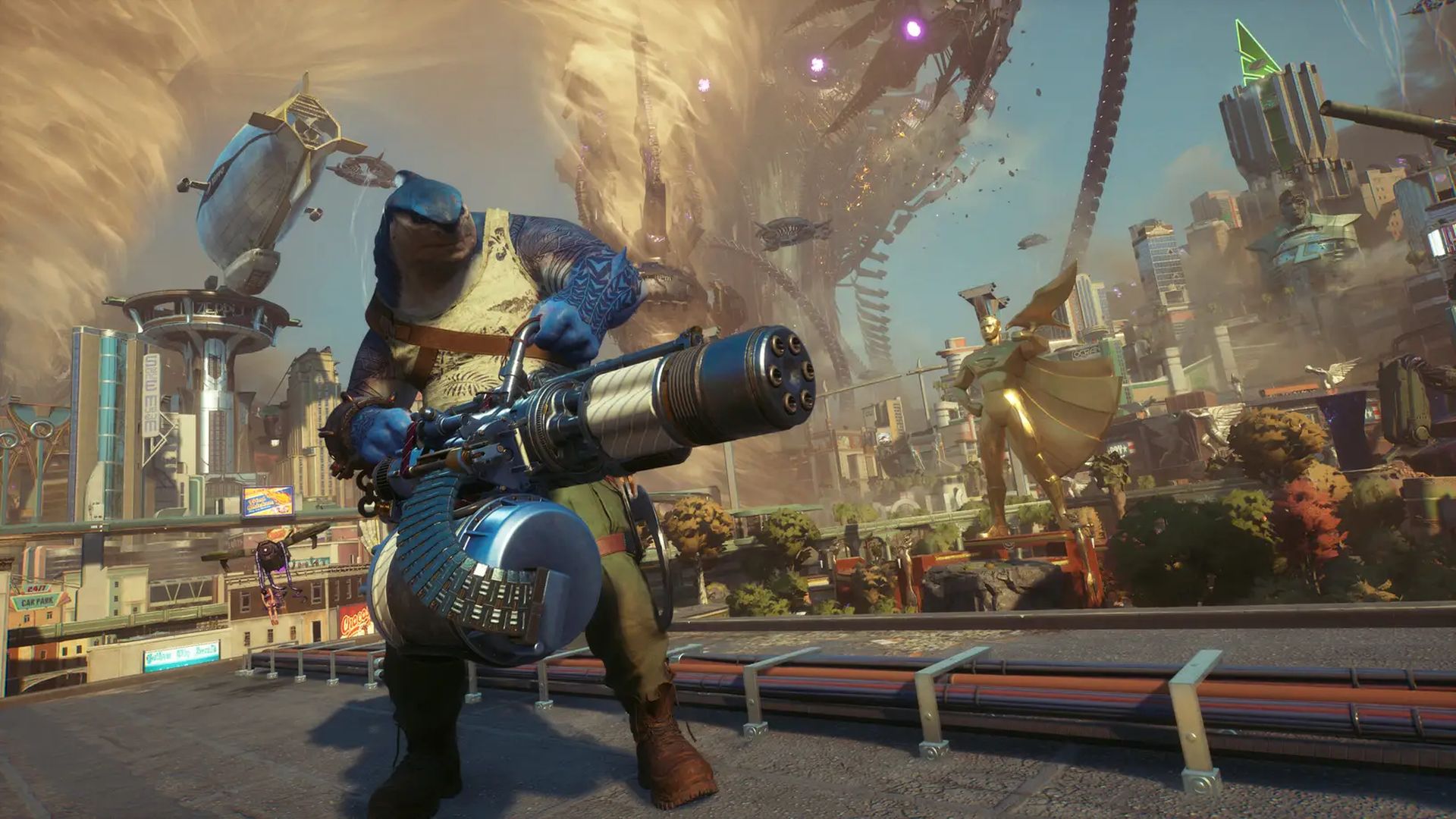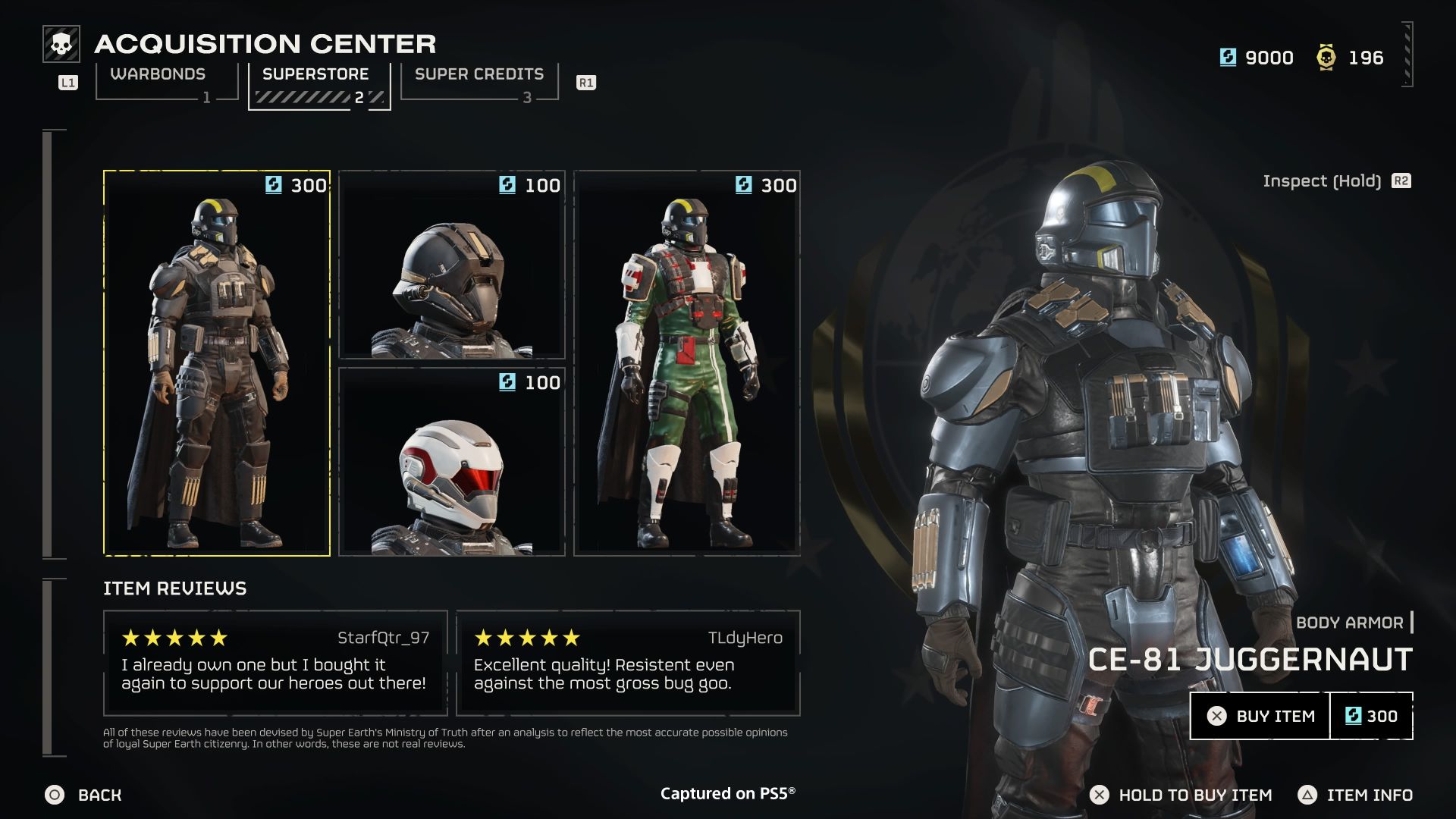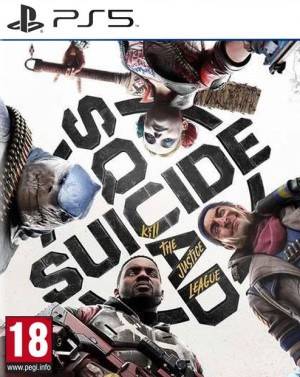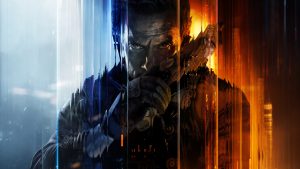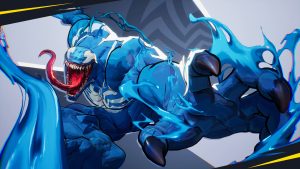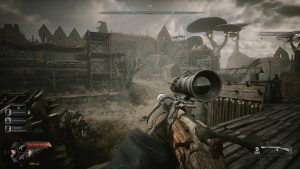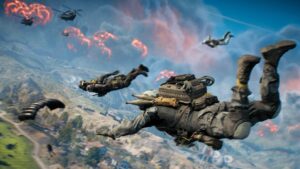
Even with the mixed impressions, live-service trappings and looter shooter gameplay, there was some anticipation for Suicide Squad: Kill the Justice League. It’s Rocksteady’s first game since 2015’s Batman: Arkham Knight, and now it’s lowest-rated, which is hardly ideal. Nevertheless, after a rumored seven years of development, it’s interesting to see it upstaged by another live-service shooter – Arrowhead Game Studios’ Helldivers 2 for PS5 and PC.
Helldivers 1 is a top-down shooter, but the developer handled the transition to third-person very well. As such, despite various issues and controversy surrounding its anti-cheat nProtect GameGuard, Helldivers 2 is touted as an example of live service done right and a great shooter on top of this. It’s also been in development for about eight years, so seeing Arrowhead maintain its vision over such a long period and deliver a solid title is worth noting.
Helldivers 2 is nearing 200,000 peak concurrent players on Steam (not to mention 360,000 concurrent players on both platforms). Meanwhile, Suicide Squad: Kill the Justice League peaked at 13,459 concurrent on Steam. What sets the two apart? How is Helldivers 2 doing so well despite so many other live-service titles, Suicide Squad included, failing to find ground?
The gameplay is perhaps worth discussing the most. Suicide Squad: Kill the Justice League is a looter shooter with a heavy emphasis on movement, which also informs the level design and boss fights. You’ll spend most of the time bounding across rooftops, staying off the streets and taking high ground. The bosses are horrible for other reasons, as others have thoroughly documented. However, if you get used to the movement, it’s possible to zip around effortlessly in Metropolis, chaining together wall runs, leaps, dashes and grapples. However, as nice as the city looks, the cityscape has little impact on the gameplay, whether it’s sunny or raining.
By comparison, Helldivers 2 is more boots on the ground and tactical. You can sprint, crouch, crawl and dive, and while there is a decent amount of deformation through the environments, elevation does play some part. It’s limited to scaling up surfaces, though you won’t be climbing mountains, using the jetpack for some added verticality on a hefty cooldown, or dropping into a higher point.
Perhaps the most important thing to note is that the high ground won’t necessarily save you since many Terminids can crawl or jump up to your position and knock you off. Similarly, the Automatons have enough firepower to dislodge you – in many cases, it’s ideal to seek cover or stay on the move.
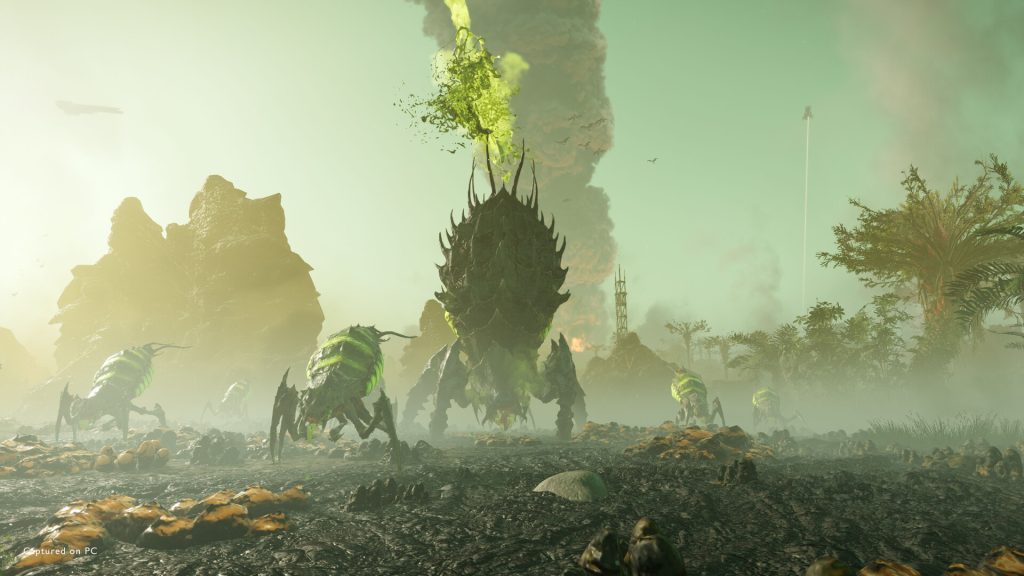
Furthermore, the environments actually play a part in combat. Outside of discovering Helldiver equipment on the field, there are unexploded Hell Bombs to shoot to wipe out scores of enemies (or yourself). Jungles affect sightlines, while some foliage and barbed wire can slow movement. Visiting a hot planet will affect your weapons, and vice versa on a cold planet. You’ll even see your character sliding a bit on the ice. There are also effects like fog, which can heavily obscure your vision and even affect the mini-map, making drops much more perilous.
Both titles are fundamentally unique in how they handle movement, and their environments facilitate those differently (though Helldivers 2 is superior, considering the latter affects your gameplay). However, the combat in both is where the really stark differences come into play.
Since Suicide Squad: Kill the Justice League is a looter shooter, it has to homogenize the gunplay across the board. Harley Quinn yields a minigun as efficiently as King Shark and Captain Boomerang is as good with a sniper rifle as Deadshot. The Talents set them apart, though they amount to damage increases, perks on reloading, damage reduction, ability cooldowns, traversal resources and whatnot. Many of the weapons also feel similar – sure, a Black Mask pistol fires differently from a Snap Shot, but several auto rifles, SMGs, sniper rifles and even shotguns feel fundamentally the same to fire.
Character abilities amount to different kinds of effects when trigging a Squad Ultimate, which slows everything around you, regardless of the character chosen; Traversal Attacks, which is essentially an enemy-clearing skill (to be fair, King Shark’s does feel distinct); and Suicide Strikes for massive single-target damage.
Their melee attacks are somewhat unique, but again, there are two options – melee from slightly farther off with Deadshot and Captain Boomerang or up close with Harley and King Shark. Grenades offer some interesting Afflictions and effects like slow-mo. Otherwise, it’s down to the loot and Talents to change how a character plays. Elements like Shield Harvesting, Counter-Shots, Affliction Strikes and Juggle Kills mix up the general gameplay, but it’s still a lot of mindless shooting.
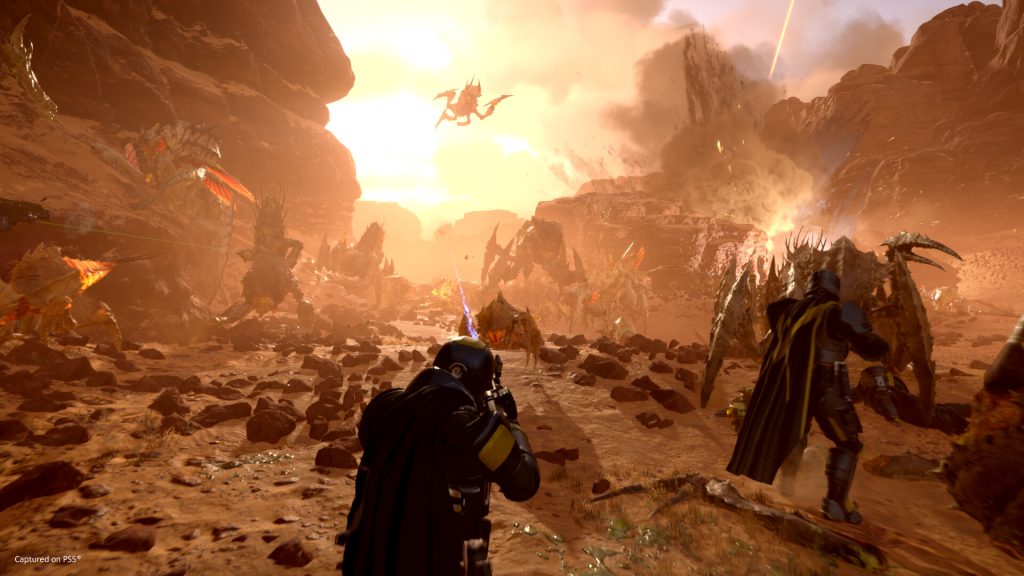
Helldivers 2 doesn’t have loot, though you will have variants on weapons like the Liberator that provide more armor piercing and explosive rounds or the Breaker with its incendiary rounds or faster fire rate. Because the title aims for a more realistic feel, the steady shots of the Liberator Explosive will feel different from the weapon sway and recoil of the regular version. Similarly, a Machine Gun is stronger and more unwieldy, requiring you to stop and reload it, while the Stalwart is faster and can be reloaded while moving but deals less damage.
It sounds simple, but you need to adjust your playstyle around these weapons, whether it’s fleeing while firing behind you with SMGs or crouching down for maximum Machine Gun efficiency. Of course, there are other nuances, like faster reloads when a single bullet remains in the chamber or losing ammo if you reload a full magazine.
Even if some weapons are better than others, your core loadout is focused heavily on Stratagems. They could technically classify as abilities while also impacting what weapons to use on the battlefield. There are specialized loadouts like Eagle Strikes, some of which are fantastic at dealing massive amounts of explosive damage but need time to rearm after a select number of uses; Turrets, which fire autonomously and range from mortar launchers to chain guns; and calling down Support weapons like the Recoilless Rifle, Railgun, Anti-Material Rifle and more.
Helldivers 2 also encourages actual cooperation with some of its weapons – the Autocannon and Recoilless Rifle fire much faster when a teammate assists with the reloads. You also need to pay attention to objectives. If Chargers are the targets, bring in a Railgun or rockets to destroy the armor on their legs and finish them off with regular weapons. If the Automatons are being the Automatons and resisting democracy, bring a shield or a barrier Stratagem for added survivability or an Anti-Material Rifle or Railgun to quickly punch through their armor. The fact that both Factions are distinct, right down to how they call for backup, also impacts your tactics.
Another area where Helldivers 2 is superior is in the objectives. Suicide Squad: Kill the Justice League offers similar missions across the board, from killing enemies and picking up things to deposit them to capturing zones and destroying crystals to blow up an Incubator. There’s a severe lack of variety, and the game attempts to make up for it by imposing frustrating restrictions like enemies only taking damage from Afflictions, Counter-Shots and whatnot.
Helldivers 2’s objectives are, well, proper military objectives. You’ll have to set up a radio tower, which includes manually orienting it (which teammates can help), or destroy Bug Nests and Automaton Factories with Stratagems, grenades or a well-placed Drop Pod. There’s a SEAF artillery gun to load, which can actually be used during the mission; a Hell Bomb to arm for destroying rogue laboratories; and even a rogue broadcast to shut down, which can be done by interacting with the console or chucking a rocket at it. There are some typical objectives, like planting Super Earth’s flags in distinct locations, delivering a drive to a Data Relay (which restricts you to a sidearm, meaning everyone else needs to protect you) and slaying hordes of enemies, but they’re interspersed between everything else.
Also, for a looter shooter that’s supposed to have an endgame, Suicide Squad has you repeating the same objective and mission types from the base game. Some modifiers are added that make a difference, like increasing enemy health and damage or causing them to evolve, and you can earn better loot, which is also very limited despite it having three tiers. If you are sick of collecting and depositing things or defending Ivy’s plants, then it’s not for you. There’s also a rematch against the final boss, who is one of the worst bosses ever created.
Helldivers 2, on the other hand, has an enormous Galactic War campaign that plays out over months. You team up with other Helldivers to liberate other planets, with complete objectives adding a bit more to the liberated status. Clear a system, and it’s on to the next one – pretty straightforward. However, multiple difficulties influence the number of missions in each Operation while also doling out more rewards.
The endgame is tackling more challenging difficulties and unlocking all the Ship Upgrades and Stratagems while one-upping the Automatons and Terminids. Again, it sounds simple, but there are high stakes and personal drama, and when you see a planet has been liberated, there’s a discernible feeling of having done your part. Meanwhile, in Metropolis, the Justice League and the final boss could be dead, but the city is still the same because, of course, it is.
Finally, there’s the topic of monetization. Suicide Squad: Kill the Justice League has an in-game store that sells cosmetics for real money. There are some to unlock in the base game with color options, but if you want the good stuff, pony up some cash. Even a single recolor costs more than $5.
Helldivers 2 also has microtransactions and garnered controversy for putting armor and weapons in its Premium War Bond (with armor also appearing in the shop). However, they don’t provide an advantage over everything you earn for free. If you decide to spend money, the cheapest armor will cost about $2.
Of course, there’s also the fact that you can get the premium currency, Super Credits, by simply exploring in-game or from the free War Bond with Medals earned by completing missions. The rate at which they’re earned, combined with the relatively low cosmetic prices, is a big advantage over Suicide Squad. At least Battle Passes for the latter don’t expire, just like War Bonds in Helldivers 2, which is nice.
There are some areas where one could credit Suicide Squad over Helldivers 2 like the cutscenes and voice acting. Story and sound design are more subjective, though both are very good at the latter. You could even say that Quickplay is superior in Rocksteady’s looter shooter because it actually works, compared to Arrowhead’s where even manually searching lobbies doesn’t guarantee you’ll get into a game. Plus, Suicide Squad will add an offline option at some point, whereas Helldivers 2 isn’t planning for the same and doesn’t scale well when solo.
However, Helldivers 2 wins simply by virtue of presenting a compelling live-service game that feels alive and contextualizes your actions against the in-game narrative. Even when it comes to the gameplay, it just feels better, with more options and variety. I care about my teammates when they’re not there as much as I fear them when avoiding friendly fire and danger-close Eagle Strikes. I couldn’t care less about my AI teammates in Suicide Squad until it comes time to level them because XP isn’t shared, and that means grinding out Talent Points to make them effective. Also, why would I level up the other heroes when the basic gameplay loop is the same?
Both titles have a ways to go in adding new content and quality-of-life features. As it stands, Helldivers 2 presents a stronger base and universe in that players are willing to spend long hours without fleecing them of their money. If nothing else, it’s $39.99 compared to Suicide Squad’s $69.99. In terms of hours played to money spent, it’s the better long-term deal going by the current Galactic War campaign alone.
Note: The views expressed in this article are those of the author and do not necessarily represent the views of, and should not be attributed to, GamingBolt as an organization.








